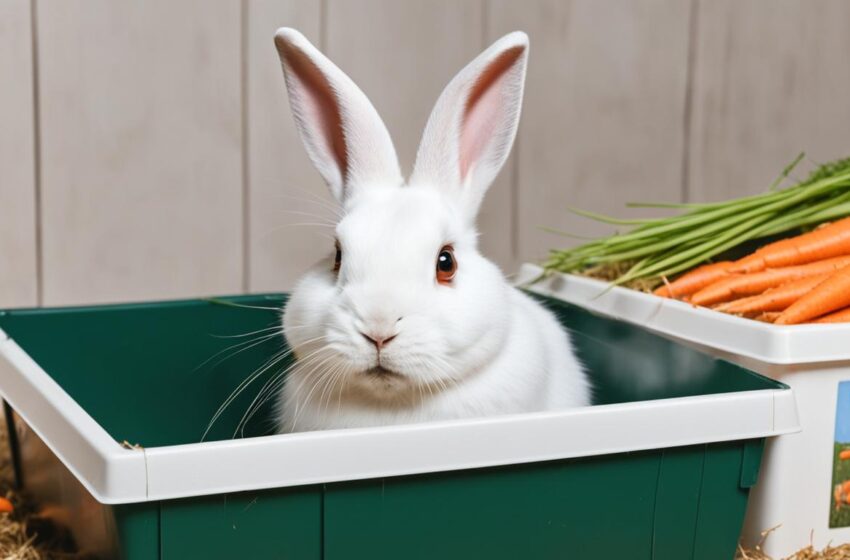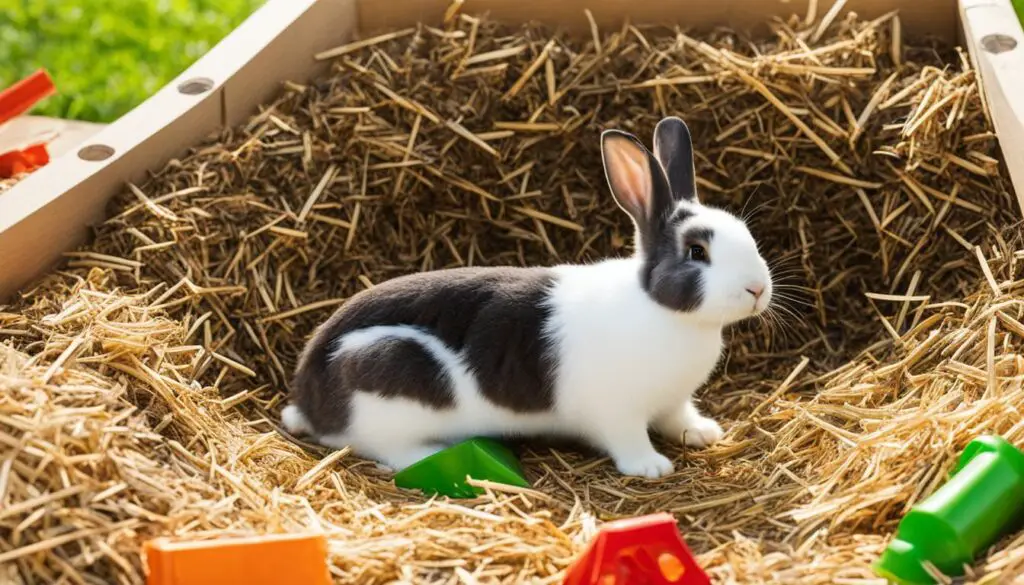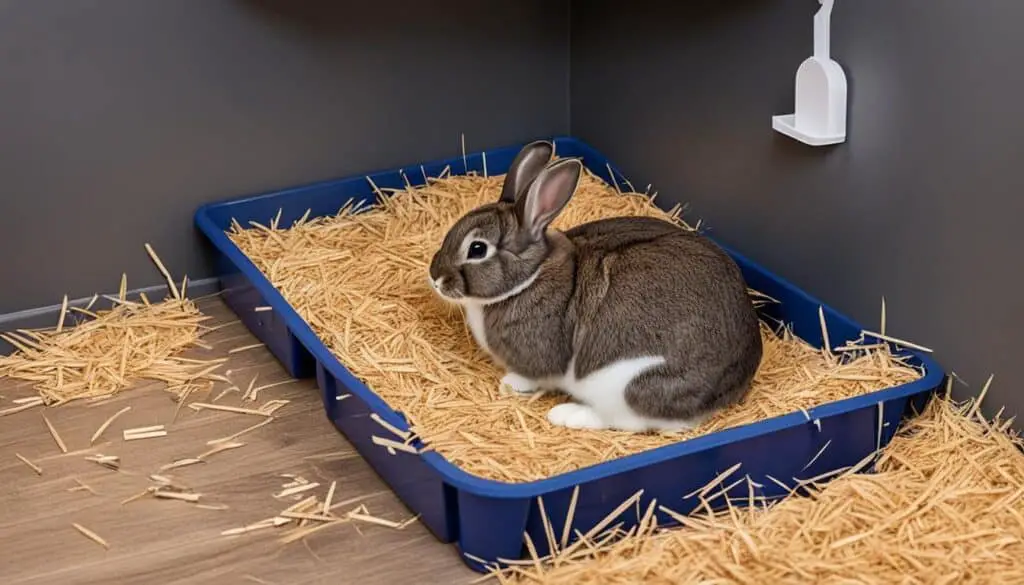The Basics of Litter Training Your Rabbit

Litter training your rabbit is an important aspect of their care. Not only does it help maintain a clean and hygienic living environment for you and your furry friend, but it also promotes good behavior and reduces the risk of accidents. Whether you’ve just brought home a new pet rabbit or you want to improve your current rabbit’s litter habits, this rabbit training guide will provide you with the necessary information and tips to successfully litter train your furry companion.
Key Takeaways:
- Litter training your rabbit is important for maintaining a clean living environment.
- Understanding your rabbit’s needs and behaviors is crucial for successful litter training.
- Providing a safe and nurturing environment is key to encouraging litter box usage.
- Regular health checks and grooming are important for your rabbit’s overall well-being.
- Social interaction and bonding with your rabbit are essential for their happiness.
Understanding Your Rabbit’s Needs
Before you start litter training your rabbit, it’s important to understand their basic needs and behaviors. Rabbits are social, intelligent, and curious animals that require a stimulating environment to thrive.
Rabbits are social, intelligent, and curious animals that require a stimulating environment to thrive.
One of the most crucial aspects of rabbit care is their diet. Rabbits have specific dietary requirements, and their diet plays a vital role in their overall health and well-being. Hay is an essential component of their diet, providing necessary fiber and aiding in digestion.
Rabbit Behavior
- Rabbits are social animals and enjoy the company of both humans and other rabbits.
- They are intelligent creatures that require mental stimulation through play and exploration.
- Rabbits are naturally curious and love to explore their surroundings.
- They have a natural instinct to dig, chew, and mark their territory.
In order to provide the best care for your rabbit, it’s important to research their natural behaviors and create an environment that allows them to express these behaviors.
Rabbit Care and Diet
Proper rabbit care involves providing them with a balanced diet that meets their nutritional needs. In addition to hay, rabbits should have access to fresh vegetables, a limited amount of pellets, and plenty of clean water.
- Research what foods are safe for rabbits and avoid feeding them anything that may be harmful.
- Offer a variety of vegetables to ensure they receive a rich and diverse diet.
- Avoid excessive treats and high-sugar foods that can lead to health issues like obesity and dental problems.
Incorporating a well-balanced diet into your rabbit’s care routine is essential for their overall health and longevity.
Understanding your rabbit’s needs in terms of their behavior and diet is fundamental to providing them with the best care possible. By creating a stimulating environment and ensuring a balanced diet, you can help your rabbit thrive both physically and mentally.
Creating a Safe and Nurturing Environment
When it comes to successfully litter training your rabbit, creating a safe and nurturing environment is crucial. The rabbit’s cage or hutch should provide both comfort and ample space for your furry friend. It’s important to ensure that there is a designated area for the litter box, promoting consistency in their training.
Rabbit-proofing your home is another essential step in providing a hazard-free environment for your pet. Take the time to identify potential dangers such as electrical cords, toxic plants, and small objects that your rabbit may chew on or ingest. Implementing measures to mitigate these risks will help keep your rabbit safe and prevent accidents.
Rabbit enrichment is an often overlooked aspect of their care but plays a significant role in their overall well-being. Providing enrichment activities such as toys, tunnels, and foraging opportunities can stimulate your rabbit’s mind and keep them engaged and active. By encouraging natural behaviors like exploring, chewing, and digging, you can create a mentally and physically enriching environment for your rabbit.
“A safe and nurturing environment is vital for successful rabbit training. This includes a comfortable cage or hutch, rabbit-proofing your home, and providing enrichment activities to keep them mentally and physically stimulated.”
Benefits of Rabbit Enrichment
Enrichment activities not only keep your rabbit entertained, but they also provide several important benefits. Here are a few reasons why rabbit enrichment should be an integral part of their living environment:
- Prevention of boredom and destructive behaviors caused by a lack of mental stimulation.
- Promotion of exercise and physical activity, which is essential for maintaining a healthy weight and preventing obesity.
- Reduction of stress and anxiety by giving them outlets for natural behaviors.
- Enhancement of the bond between you and your rabbit through interactive play and shared experiences.
By prioritizing the safety and well-being of your rabbit and providing opportunities for enrichment, you are creating an environment that supports their natural behaviors and contributes to successful litter training.
| Enrichment Toys | Benefits |
|---|---|
 | Stimulate mental activity and prevent boredom |
| Chew toys | Keep teeth healthy and prevent overgrown teeth |
| Tunnels and hideaways | Provide a sense of security and encourage exploration |
| Foraging toys | Simulate natural foraging behaviors and provide mental stimulation |
Remember to regularly assess and rotate enrichment options to keep things interesting for your rabbit. Introducing new toys, rearranging tunnels, and changing up foraging opportunities will prevent boredom and make their living space a dynamic and engaging environment.
Regular Health Checks and Maintenance
Maintaining your rabbit’s health requires regular attention and care. Rabbits are skilled at hiding signs of illness, so regular health checks are crucial. This includes monitoring their eating and bathroom habits, as well as checking their eyes, ears, teeth, and fur for any signs of problems. Regular grooming and nail trimming are also important for their overall well-being.
Rabbits groom themselves by licking their fur, but it’s still important to assist with their grooming to ensure their coat remains clean and free from matting. Grooming helps to remove loose hair, prevent hairballs, and keep their skin healthy. Use a soft brush or comb to gently remove any tangles or shed fur.
When it comes to nail trimming, it’s crucial to keep your rabbit’s nails at an appropriate length to avoid discomfort or injury. Overgrown nails can cause pain and make it difficult for rabbits to walk properly. Regular clipping or filing can help prevent these issues. If you’re unsure about how to properly trim your rabbit’s nails, consult a veterinarian or a professional groomer.
| Health Check | Frequency |
|---|---|
| Eating habits | Check daily for any changes in appetite or behavior |
| Bathroom habits | Monitor litter box usage and check for any abnormalities |
| Eyes, ears, and teeth | Inspect weekly for any signs of infection, discharge, or dental issues |
| Fur and grooming | Groom gently and regularly to prevent matting and hairballs |
| Nail trimming | Trim or file nails every 4-6 weeks, or as needed |
Quote:
“Regular health checks and grooming are essential for maintaining your rabbit’s well-being. By monitoring their eating and bathroom habits, as well as ensuring their eyes, ears, teeth, and fur are in good condition, you can catch any potential issues early and provide timely care. Don’t forget regular nail trimming to keep them comfortable and prevent any mobility issues.”
Social Interaction and Bonding
Rabbits are highly social animals that thrive on interaction and bonding. Spending quality time with your rabbit is essential for their happiness and well-being.
If possible, consider introducing another rabbit as a companion for your furry friend. Rabbits form strong bonds with their companions and can benefit from the socialization and companionship.
However, it is important to introduce rabbits gradually and carefully to ensure a successful bond. Rabbits can be territorial and may need time to adjust to a new companion. Provide separate living areas initially and gradually increase supervised interactions to allow the rabbits to get acquainted.
Bonding with your rabbit through gentle interaction and playtime can also strengthen the bond between you and your pet. Engage in activities that your rabbit enjoys, such as petting, grooming, or playing with toys.
Remember, each rabbit has its own personality, and it may take time to build trust and establish a strong bond. Be patient and consistent in your efforts, and you will be rewarded with a loving and trusting relationship with your rabbit.
Benefits of Rabbit Companionship
Rabbits are naturally social animals and thrive in the company of their own kind. Here are some benefits of rabbit companionship:
- Reduced loneliness: Having a companion can alleviate feelings of loneliness and boredom in rabbits, promoting their overall well-being.
- Stimulation and enrichment: Interactions with a companion rabbit can provide mental and physical stimulation, encouraging natural behaviors and preventing boredom.
- Enhanced communication: Rabbits communicate with each other through various body language and vocalizations. Having a companion allows rabbits to engage in natural communication, promoting socialization and understanding.
- Improved grooming habits: Rabbits groom each other as a form of bonding and socialization. Having a companion encourages regular grooming, which helps maintain healthy fur and prevents matting.
| Benefits of Rabbit Companionship | Description |
|---|---|
| Reduced loneliness | Having a companion can alleviate feelings of loneliness and boredom in rabbits, promoting their overall well-being. |
| Stimulation and enrichment | Interactions with a companion rabbit can provide mental and physical stimulation, encouraging natural behaviors and preventing boredom. |
| Enhanced communication | Rabbits communicate with each other through various body language and vocalizations. Having a companion allows rabbits to engage in natural communication, promoting socialization and understanding. |
| Improved grooming habits | Rabbits groom each other as a form of bonding and socialization. Having a companion encourages regular grooming, which helps maintain healthy fur and prevents matting. |
Training Your Rabbit to Use a Litter Box
Training your rabbit to use a litter box requires time, patience, and a thoughtful approach. By following a few key tips, you can successfully teach your furry friend to use a litter box consistently. Here are some essential tips for litter training your rabbit:
1. Choose the Right Litter Box and Litter Material
Selecting the right litter box and litter material is crucial for successful litter training. Choose a litter box that is large enough for your rabbit to comfortably enter and turn around in. Avoid using litter boxes with high sides, as rabbits prefer low-entry boxes. As for the litter material, opt for a safe and absorbent option such as paper-based pellets or compressed straw. Avoid using clay or clumping litter as they can be harmful if ingested.
2. Start the Training Process in a Small, Confined Area
When beginning litter training, it’s best to start in a smaller, confined area such as a playpen or a limited section of your home. This reduces the chances of accidents and allows your rabbit to develop a familiarity with the litter box. Gradually expand the space available to your rabbit as they become more consistent in using the litter box.
3. Use Positive Reinforcement Techniques
Positive reinforcement is an effective tool in training your rabbit to use a litter box. Whenever your rabbit uses the litter box correctly, reward them with a treat or praise. This helps to reinforce the behavior and encourages your rabbit to continue using the litter box. Avoid using punishment or negative reinforcement, as it can create fear and hinder progress.
4. Maintain Consistency and Patience
Consistency is key when it comes to litter training your rabbit. Ensure that the litter box is kept clean and fresh, as rabbits are more likely to use a clean litter box. If accidents occur outside the litter box, clean up the area promptly and place any soiled litter in the litter box to help establish a familiar scent. Be patient throughout the training process and understand that accidents may happen occasionally.

Training your rabbit to use a litter box may require some time and effort, but with the right approach and a little patience, you can achieve success. Remember to choose the appropriate litter box and litter material, start in a small area, use positive reinforcement, and maintain consistency. Your rabbit will soon learn to use the litter box consistently, creating a cleaner and more pleasant living environment for both of you.
Troubleshooting Common Litter Training Challenges
Litter training your rabbit is a rewarding process, but it can sometimes come with its fair share of challenges. Understanding and addressing these issues is essential to ensure a successful outcome. Here are some common problems that you may encounter during the litter training process:
Litter Training Problems
While most rabbits can be successfully litter trained, there may be instances where they struggle to adapt to using a litter box. Some of the potential problems include:
- Rabbit accidents outside the litter box
- Litter box refusal
When faced with these challenges, it’s important to remain patient and persistent. Understanding the underlying causes can help you implement the appropriate strategies to overcome them.
Causes and Solutions
Accidents outside the litter box can occur due to various reasons. It could be territorial marking, learned behavior, or even medical issues. To address this problem, try the following:
- Clean accidents promptly: Remove any traces of urine or feces promptly to discourage repetitive accidents in the same spot.
- Increase litter box availability: Provide multiple litter boxes in different areas to increase accessibility for your rabbit.
However, if your rabbit refuses to use the litter box altogether, it’s crucial to investigate the underlying cause. Here are some potential reasons and corresponding solutions:
Territorial marking: If your rabbit is marking their territory by urinating outside the litter box, consider neutering or spaying them. This can help reduce territorial behavior and facilitate litter training.
Medical issues: In some cases, refusal to use the litter box may be a result of a medical condition. If you suspect this to be the case, consult with a veterinarian to rule out any underlying health problems.
Tips for Success
When troubleshooting litter training challenges, keep the following tips in mind:
- Consistency is key: Continue reinforcing positive behavior and consistently redirecting your rabbit to the litter box when accidents occur.
- Use positive reinforcement: Reward your rabbit with treats or praise when they successfully use the litter box. This will encourage them to repeat the desired behavior.
Summary
Troubleshooting common litter training challenges is an important part of the overall training process. By understanding the underlying causes and implementing appropriate solutions, you can overcome obstacles and successfully achieve litter training for your rabbit.
Conclusion
In conclusion, litter training your rabbit is a valuable endeavor that can greatly benefit both you and your furry companion. Through understanding your rabbit’s needs, creating a safe and nurturing environment, and providing consistent care and social interaction, you can successfully train your rabbit to use a litter box.
By taking the time to research and implement the proper techniques, you can create a cleaner and more hygienic living space for both you and your rabbit. Remember to be patient and loving throughout the training process, as rabbits can be sensitive creatures that respond well to positive reinforcement.
Through consistency and dedication, you can establish a strong bond with your litter-trained rabbit and enjoy the benefits of a well-behaved and happy pet. So, embark on this rewarding journey of litter training and embrace the joy of caring for a rabbit that uses a litter box.
FAQ
How do I start litter training my rabbit?
To start litter training your rabbit, you will need to choose the right litter box and litter material. Begin by confining your rabbit to a small area with the litter box, gradually expanding their space as they become comfortable using it. Use positive reinforcement techniques, such as treats and praise, to encourage your rabbit to use the litter box consistently.
What should I do if my rabbit has accidents outside the litter box?
Accidents outside the litter box may happen during the training process. If your rabbit has accidents, clean up the mess with an enzymatic cleaner to remove any scent that may attract them to the same spot. Reassess the size and location of the litter box, and make sure it is easily accessible for your rabbit. Keep providing positive reinforcement for using the litter box correctly and be patient with your training efforts.
What if my rabbit refuses to use the litter box?
If your rabbit refuses to use the litter box, it’s important to rule out any underlying medical issues that may be causing this behavior. In some cases, territorial marking or stress can also lead to litter box refusal. Ensure that the litter box is clean and comfortable, and consider adding multiple litter boxes in different areas to create more options for your rabbit. Consult with a veterinarian or a rabbit behavior specialist for further guidance.
Can I use any type of litter for my rabbit’s litter box?
It is essential to choose a safe and appropriate litter material for your rabbit’s litter box. Avoid using clumping clay litter, as it can be harmful if ingested. Instead, opt for non-toxic options such as recycled paper-based litter or wood pellets. Some rabbits may have preferences, so you may need to experiment to find the litter material that your rabbit is most comfortable with.
How long does it take to fully litter train a rabbit?
The time it takes to fully litter train a rabbit can vary depending on the individual rabbit and their previous experience. With consistent training efforts and a positive reinforcement approach, most rabbits can be successfully litter trained within a few weeks to a few months. However, it’s important to remember that each rabbit is unique, and some may require more time and patience.



